
Adonis is a genus of about 20–30 species of flowering plants of the crowfoot family, Ranunculaceae, native to Europe and Asia.
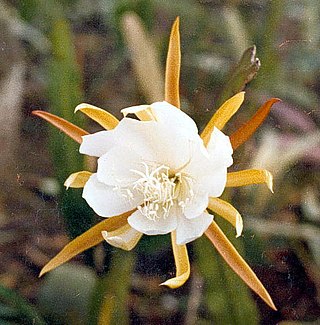
Epiphyllum laui is a cactus species native to Mexico and grown as an ornamental.

Dudleya multicaulis is a succulent plant known by the common name manystem liveforever or many-stemmed dudleya. This Dudleya is endemic to southern California, where it is rare and seriously threatened as its habitat is altered by humans. Many occurrences of this species have been extirpated. This species is characterized by a few short, fingerlike cylindrical leaves with pointed tips, and its erect peduncle, which is topped with a branching inflorescence bearing up to 15 flowers on each long, thin branch. The flowers, which appear in late spring, have pointed yellow petals and long stamens. It is usually found on heavy clay or rocky soils and outcrops.

Brunfelsia pauciflora is a species of flowering plant in the family Solanaceae, the nightshades. It is endemic to Brazil, and it is grown in cultivation. A shrubby perennial plant grown in gardens, its common names include today, tomorrow together, morning-noon-and-night, kiss me quick, and Brazil raintree.
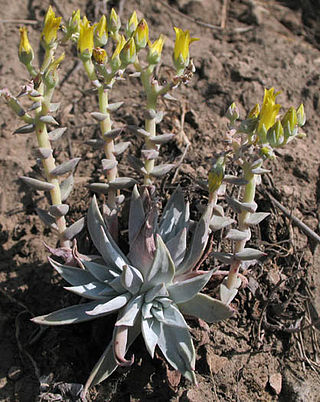
Dudleya verityi is a rare species of succulent plant known by the common name Verity's liveforever. It is endemic to Ventura County, California, where it is known from only three occurrences in the vicinity of Conejo Mountain between Camarillo and Thousand Oaks. It probably occurs in a few additional locations nearby which have not yet been officially vouchered.
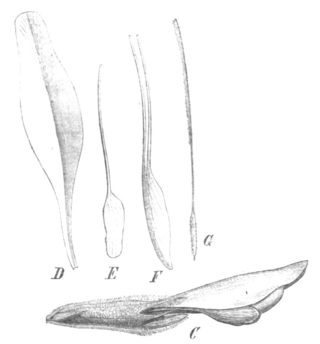
Barbieria is a genus of flowering plants in the legume family, Fabaceae.

Olearia asterotricha, commonly known as rough daisy-bush, is a species of flowering plant in the family Asteraceae. A tall shrub with white, mauve or blue daisy like flowers growing from the Blue Mountains in New South Wales to western Victoria, Australia.
Trompettia cardenasiana is a species of nightshade that is a spiny shrub bearing very small leaves, 0.35–0.5 cm (0.1–0.2 in) by 0.1–0.12 cm (0.04–0.05 in), a yellow trumpet-shaped campanulate flower, measuring about 3 cm (1.2 in) long and globose fruit. The growth habit is somewhat reminiscent of certain Lycium species. It is endemic to Bolivia, growing in dry, Andean valleys at altitudes of 2,000–2,500 m (6,600–8,200 ft) and 3,000–3,500 m (9,800–11,500 ft) and has been collected near the town of Cotagaita in Potosí Department.

Dudleya attenuata is a species of perennial succulent plant known by the common name taper-tip liveforever, native to Baja California and a small portion of California. A rosette-forming leaf succulent, it has narrow pencil shaped leaves that can often be found covered in a white epicuticular wax. The thin, sprawling stems branch to form the clusters of rosettes, with plants creating a "clump" up to 40 cm wide. The small flowers are white or yellow, with 5 spreading petals. It is a diverse, variable species that extends from the southernmost coast of San Diego County to an area slightly north of the Vizcaino Desert, hybridizing with many other species of Dudleya in its range. Some plants with white or pinkish flowers were referred to as Orcutt's liveforever, referring to a former subspecies split on the basis of the flower color.
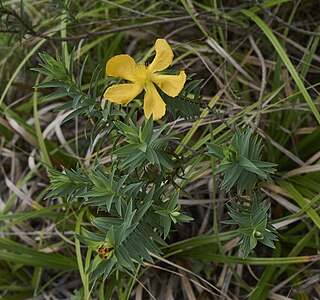
Hypericum terrae-firmae is a woody perennial flowering plant in the St. John's wort family Hypericaceae. It is an endemic plant species of Belize.
Hypericum acmosepalum is a dwarf shrub in Hypericumsect. Ascyreia that is native to China and known as jian e jin si tao locally.

Clematis hedysarifolia is a liana, endemic to peninsular India, belonging to the buttercup family (Ranunculaceae). It was described by Augustin Pyramus de Candolle and published in Regni Vegetabilis Systema Naturale 1: 148, in 1817.

Passiflora bogotensis is a climbing plant native to Colombia, in the genus Passiflora. It can also be found in Venezuela.
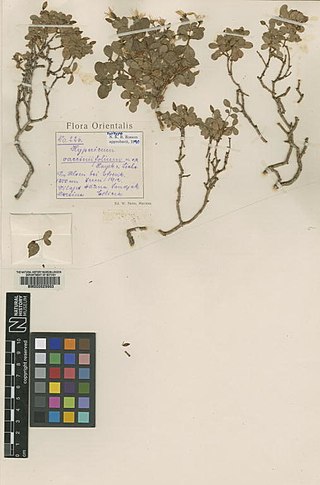
Hypericum vacciniifolium is a species of flowering plant in the flowering plant family Hypericaceae. It was first described by August von Hayek and Walter Siehe in the Ann. K. K. Naturhist. Hofmus. journal in 1914 from a specimen collected by Siehe in 1912.

Polypsecadium is a genus of large herbaceous species of plants in the family Brassicaceae, found growing in South America. Most of the species were formerly classified in the genus Sisymbrium.

Dudleya rubens is a species of succulent perennial plant in the family Crassulaceae known by the common name as the San Francisco liveforever, native to the mountains of Baja California Sur. It is a rosette-forming plant with waxy leaves, characterized by branching stems and dull red to apricot flowers. It is only found above 500 metres (1,600 ft) in the Sierra de San Francisco and the Sierra de la Giganta ranges in Baja California Sur, primarily on north-facing volcanic slopes.
Hedinia is a monotypic genus of flowering plants belonging to the family Brassicaceae. It only contains one known species, Hedinia tibetica.
Zanthoxylum glomeratum is a woody plant in the Rutaceae family, it is native to Southeast and South-Central China.
Dudleya cymosasubsp. costatifolia, known commonly as the Pierpoint Springs dudleya or the Pierpoint Springs liveforever, is a species of succulent plant in the family Crassulaceae, narrowly endemic to a locality in Tulare County, California, United States. It is a clumping plant with small rosettes and bright yellow flowers, resembling alpine cushion plants.
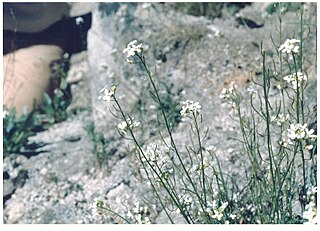
Sandbergia is a genus of flowering plants belonging to the family Brassicaceae. They are also in the Boechereae Tribe.














